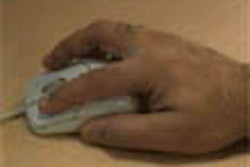Mobile computing devices such as personal digital assistants (PDAs) can be used to improve communications between emergency (ED) and radiology departments, according to researchers from the University of California, San Francisco.
"PDAs are a viable means for accessing clinical data," said Wyatt Tellis, a graduate student in UCSF's biomedical informatics program.
Tellis presented the team's research during the R&D Committee Symposium at the 2004 Society for Computer Applications in Radiology (SCAR) meeting in Vancouver.
Believing that the communication of urgent exam results to the ED was a process that might benefit from the application of information technologies, a UCSF team began a multistage project to replace the existing fax-based procedure.
In the old process, the radiologist would receive the paper exam requisition, which was used as a cue to review the exam. The radiologist would place the findings on the requisition, which would then be faxed to the ED. At the ED, a clerk would place the requisition in the patient's chart for the ED physician to review.
With this process, wet reads were stored in hard-copy form only, and couldn't be recovered if lost by the radiologist or the ED, Tellis said. This procedure also made quality assurance (QA) more difficult, as statistics must be extracted manually, he said.
In addition, handwritten text is more likely to be misinterpreted. The use of batch faxing led to delays, and there was no mechanism for ED physicians to record their findings if they happened to see the exam first, Tellis said.
Going digitalUCSF sought to replace every step in the old process with a digital equivalent. In UCSF's new process, radiologists are encouraged to use "active" worklists to determine what urgent exams are available to be read. Most radiologists adopted the worklists, although paper requisitions are still used (and preferred) by some, Tellis said.
The radiologists record their wet reads using an internally developed embedded Web form on the PACS display station. If an ED physician reviews an exam before the radiologist, they are permitted to enter their findings, he said.
"The radiologist will notify the ED via phone if there is a discrepancy between the two interpretations," he said.
The wet-read results are available via printouts on networked printers in the ED, on ED PACS display stations, and on PDAs carried by ED physicians. If a wet read was entered by a radiology resident or fellow, then the radiology attending is expected to review it. Pertinent feedback for the resident or fellow is sent by e-mail and recorded for QA processes, Tellis said.
In the first stage of the project, a wet-read module was built to electronically capture, deliver, and track wet readings. The wet reads were entered on PACS displays and printed out in the ED. This enabled the capture of QA data for educational feedback to radiology residents and fellows, which completely replaced faxing for all urgent exams, Tellis said.
In the second stage, the UCSF team explored the use of mobile computing technologies to facilitate communications of urgent-care exam results. PDAs were used to notify ED doctors that results were available, also providing full access to text of wet reads and final reports, and reports for prior exams on the same patient.
"This was expected to further reduce the delay between when results are available and when they are first viewed by a physician," he said.
System componentsAll system components were written in Java (Sun Microsystems, Santa Clara, CA), with the open-source PostgreSQL employed for the database (used to store wet reads and timing metrics for system evaluation). The Web-based user interface on the PACS displays relied on Java Server Pages (JSP) to generate the forms, with Tomcat used as the JSP container and Web server, Tellis said.
Integration with UCSF's PACS workstation (Agfa Healthcare's Impax R4.1) included capturing clinical context (such as patient ID and accession number) using the vendor's "context server" application. Additional buttons were also added to the display station graphical user interface (GUI) using the vendor's "script button" scripting language, Tellis said.
Sun's Java Messenger Services (JMS) was used to transfer wet reads between the various system components, including the printing service, e-mail service, and radiology information system (RIS) interface.
JMS clients for the PDAs were developed using the iBus/Mobile JMS provider (Softwired, Zurich, Switzerland). The UCSF team deployed iPAQ 4150 PDAs (Hewlett Packard, Palo Alto, CA), offering a 400 MHz X-Scale CPU, 64 MB RAM, and 16K color, 320 x 240 pixels, and a 3.5-inch diagonal display. The system includes built-in wireless 802.11b support, and an extended battery was utilized to provide battery life of up to 10 hours, Tellis said.
UCSF has a hospital-wide wireless local-area network (WLAN) based on Cisco Systems' Aironet technology. Aironet employs Cisco's Lightweight Extensible Authentication Protocol (LEAP) for data encryption.
WEP encryption is employed over the WLAN, while the Data Encryption Standard (DES) was used to encrypt all data between the PDA client application and the JMS provider. LEAP authentication for device authentication is performed with a user/name password for user authentication. All usage was tracked by the wet-read application, Tellis said.
System evaluationPrior to implementation, the researchers recorded fax time stamps for 61 days, and requested ED physicians to sign off when they first viewed faxes. The study team then evaluated the system for 71 days after implementation.
The system recorded when the radiologist entered a wet read, and then when it was viewed by ED physicians on a PDA. The PDAs were also carried by residents who rotated through the ED each month, Tellis said.
The timing metrics studied were:
- Time to image availability.
- Time between scheduled exam and its availability on PACS for interpretation.
- Time to interpretation availability.
- Time from an exam's availability on PACS to its reading by a radiologist, and the results available to an ED physician.
A time-to-results encounter measures the time from when results are available to when they are first viewed by the ED physician. Availability of images improved by an average of 7.5 minutes, although this reduction can't be explained by the wet-read module, Tellis said.
"It's not actually integrated into any of those steps, so the probable explanation is maybe improvements in technologists' productivity," he said.
The time to interpretation availability was reduced by a mean of 2.9 minutes, with a median reduction of five minutes. This was attributed to the additional use of active worklists and elimination of the practice of batch-mode interpretation, Tellis said.
The biggest improvement from the new system came in the time-to-results encounter, which dropped 14.5 minutes. Although this reduction was not statistically significant due to the high variance of the datasets, the data still suggest the PDAs might have helped, Tellis said.
Total exam time was reduced by a mean of 24.8 minutes, suggesting the wet-read module has improved turnaround times. The time-to-image availability remains a confounding factor, Tellis said.
The UCSF team also performed an ED resident survey evaluating the use of PDAs. Eight of the 12 residents completed the survey, which comprised two sections. The first part covered the resident's personal experiences with their own PDAs, while the second part queried the residents about their experiences using the wet-read PDAs.
Of the respondents, six currently had their own PDA (all Palm OS), with most reporting ownership of one to three years. The most common clinical application used on the display was ePocrates.
The biggest problems encountered with the PDAs were network connectivity (cited by four respondents) and battery life (mentioned by three respondents). Three residents felt they improved patient care, and all felt PDAs could be clinically useful.
The most-requested features on the PDAs were laboratory results, order entry, and radiology images.
Overall, system feedback to the radiology department has been extremely positive, Tellis said. The system is now used for all urgent imaging examinations and for all modalities, handling approximately 90 wet reads a day.
"The reduction in timing metrics suggests that the module has helped save time in urgent-care cases, which can have a potentially positive impact on patient care," Tellis said.
By Erik L. Ridley
AuntMinnie.com staff writer
August 6, 2004
Security in the wired or wireless world: users are the weakest link, May 24, 2004
Tablet PCs show promise as mobile PACS workstations, May 23, 2004
New wireless network options offer benefits, despite security concerns, April 2, 2004
Tablet PC eases image distribution to bedside, March 23, 2004
PDAs do little to reduce documentation discrepancies, March 18, 2004
Copyright © 2004 AuntMinnie.com

















